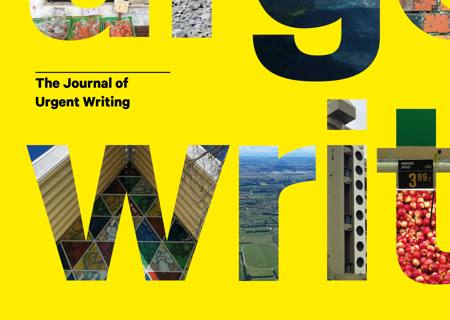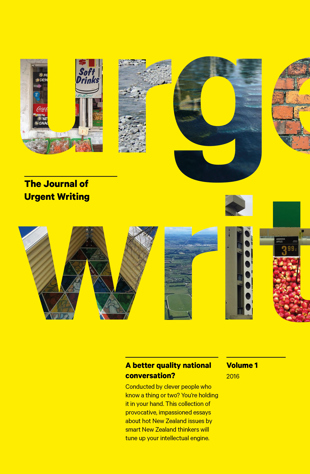Salmon on Tuna
Dan Salmon
My mum used to make a microwaved curry with canned tuna and raisins, zapped in an smoky oval Arcoroc microwave dish. My impressionable brothers loved it, or said they did, but I thought it was the second-worst meal in the world. Canned tuna was up there with Brussels sprouts for the pre-adult me. Thirty years later, forking the flaky tuna with cheese, tomato and lettuce onto a fresh baguette tastes better than a BLT. Throw some capers on that and I could eat it every day. Sadly, I’ve spent the past year talking tuna for a large NGO and my head is now so full of tuna, with every hard-earned swallow carrying such a weight of environmental and human-rights baggage, that I struggle to eat any fish at all.
Even the prescribed pole-and-line-caught can of environmentally friendly skipjack comes with the metallic aftertaste of guilt. And I’m over the jokes linking the gig to my surname. Yes, it’s an aptronym, and yes, I used it in the title, and yes, it was funny for a few minutes, but now every question from other tuna lovers seeking easy answers in a complex world simply sinks me deeper into a fish-free miasma.
I’ve directed enough dog-show reality TV to know that the way individuals treat animals generally reflects the way they treat people. I haven’t come to the fisheries conversation from an animal-rights perspective, but I can see how you might. From the mighty bluefin and the imaginatively named yellowfin, to the ubiquitous skipjack and albacore, the blackfins and longtails, bullet tuna, slender tuna and the little tunny, tuna are astonishing animals. Fifteen species across five genera, they’re not one fish. There are so many species, so many ways of fishing for them, and so many different countries, companies and cultures catching and consuming them, that everything I say about tuna has to be checked by the lawyers, checked by the scientists, then checked by the lawyers again; by then it no longer makes sense, and it all needs a redraft, which will of course need rechecking. Some tuna are on the verge of collapse, a technical word you have to be very careful how you use, but, while tuna populations have declined on average by 60 per cent over the last half-century, there are still some; if we can fix the way they’re caught, that could continue to feed and employ millions of us for the foreseeable future.
Sleek and streamlined, tuna are built for speed. Through chemical trickery, they, along with mackerel sharks, are the only fish that run their body heat higher than the surrounding water. In the ocean, they are like the fleetest of birds or the most agile of great cats. Powerful, hairless aqua-cheetah. I’ve watched them from the mast-top, flashing silvery blue or yellow, and they are fast, man are they fast. I love them as wild animals, but I also love to eat them, and there in that very human contradiction lies the rub, the marinade and the wasabi. The problem is that the very people who catch them are the people who make me feel bad about eating them.
Tunnies, pelamyds and bonitos enter the Pontus in spring and spend the summer there, and so do practically the majority of the shoaling and gregarious fishes.
— Aristotle, History of Animals, 350 BC
We’ve been eating tuna since before Jesus, but it should surprise no one that the biggest run on them began in the twentieth century. The US tuna industry, synonymous with the canned-tuna industry, was born when a San Diego sardine fisherman met a seasonal sardine shortage with the local albacore. While soldiers on the battlefields of both world wars ran on the US-caught protein, tuna only replaced sardines on US supermarket shelves when the sardine industry collapsed — a moment in time immortalised in John Steinbeck’s Cannery Row, named after Monterey’s sardine-factory seafront street. The real-life version of his character Doc, a marine biologist known as Ed Ricketts, investigated where all the sardines had gone. His answer: ‘They’re in cans.’
Cannery Row is now home to the respected Monterey Bay Aquarium Research Institute. It’s a good-news place with great bars and restaurants, a tourist town that celebrates the abandoned sardine factories with frou-froued façadism, preserving the proud image of the industry with new paint and cheerful signs, while ignoring the dark side: Steinbeck’s whores and homeless, and the collapse of the fisheries. The only sign I found there of the once-popular novelist was a faded awning marking the backstreet entrance of Steinbeck Plaza, home to the Candy Factory, Sharky’s Shirts and Adventures By The Sea.
As a species ourselves, we don’t tend to learn from our fuck-ups. We can still buy sardines from the supermarket, so things can’t be too bad — right? Globally, we pull over 7 million tonnes of tuna out of the ocean each year. In 1950, as sardines collapsed, we were only taking 0.6 million tonnes. If we’re talking the small animals, most of it goes into cans. If we’re talking the big species, it becomes sushi and steaks. Eighty per cent of the world’s sashimi tuna is eaten in Japan. Hold on to that figure for a second. If you’re not from Japan, enjoy the feeling of ‘Oh, it’s them again’ for just a few moments longer. And stop.
The most valuable wild animal in the world is not the white rhino, which is killed for its horn, nor the leopard, which is killed for its hide, nor the brown bear, which is killed for its gallbladder. It is the giant bluefin tuna.
— John Seabrook, ‘Death of Giant’, from Harper’s Magazine, June 1994
Horrified by the latest Ricky Gervais social-media shaming of an ersatz-sexy corporate Ayn Rand acolyte with gun in one hand and dead endangered beast underfoot, we revel in the opprobrium, greedily sucking oxygen from the public-media pile-on as we outrage-emoji our way to a climax of self-righteousness. Dentists from the Midwestern US or the over-entitled children of property developers, these people are not hunters: they are the most vain of consumers. They never understood the metaphor in Moby Dick. Their mothers never told them the world was theirs to share, not destroy.
How we judge. And yet, every second photo on Tinder has a bloke with a fish or a fish-chasing boat, and close friends order at-risk species in restaurants or bring home orange roughy. Social media has no reaction at all when tuna chasers from our own South Island brag-flaunt photos of fresh-caught, critically endangered southern bluefin tuna loaded into trucks for big-buck export.
Why the double standard? Is it because we can’t see undersea, or that we choose to believe the myth that fish are cold-blooded and don’t feel pain? Southern bluefin are warm-blooded; they can accelerate almost as fast as a Tesla (faster than a sad-arse Porsche). They have a light-sensing third eye, a pineal organ they use to navigate thousands of miles of ocean like sleek, shiny godwits the size of a small submarine.
They are our lion, our rhinoceros, our giraffe, and yet we seem to like them best in a trophy shot, hanging from the tail, with some bloke or blokette in rugby shorts and beer-brand T-shirt smirking at the extraordinary skill their wallet has given them in pulling yet another spectacular wild animal from our oceans.
I fish. I’ve been pig hunting. I didn’t stick the pig but I was holding a camera and doing my own sort of shooting. I know industry is important, jobs are good, and we all have to eat. I believe we should have a fishing industry. I’m not precious about this stuff, but the numbers in which the industry is killing these wild animals are insane and unsustainable. The double standards touch us all. The pescatarian who says ‘I don’t eat meat but I eat fish’ is like a gin-drinking teetotaller. Here is a cold, hard fact: fish flesh is meat. If you eat fish you are not a vegetarian (pauses for mass social-media defriending by half of Grey Lynn).


